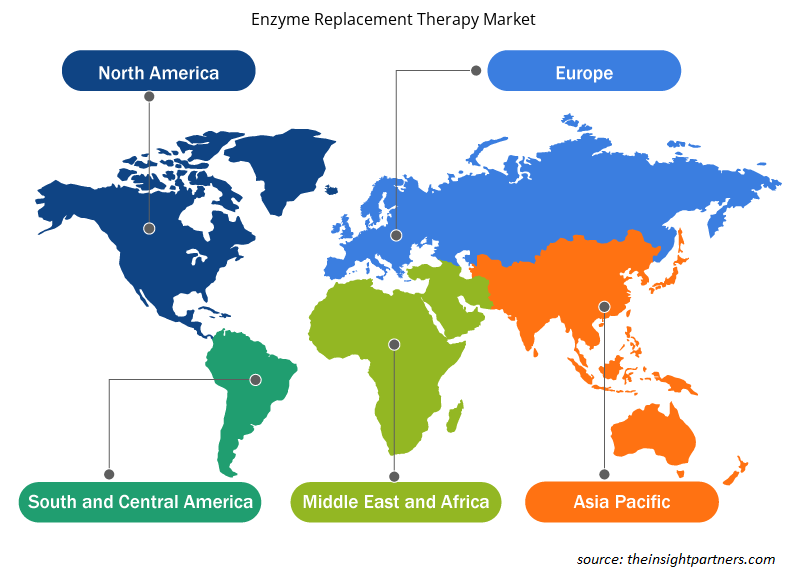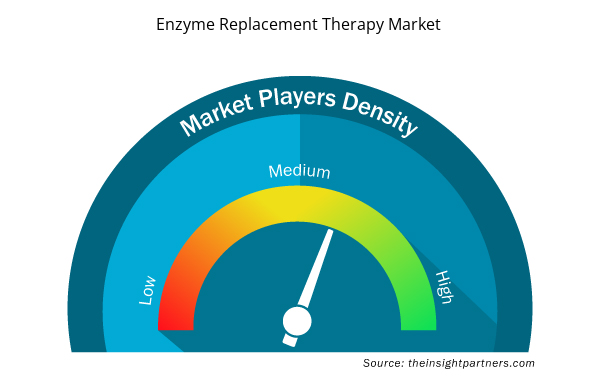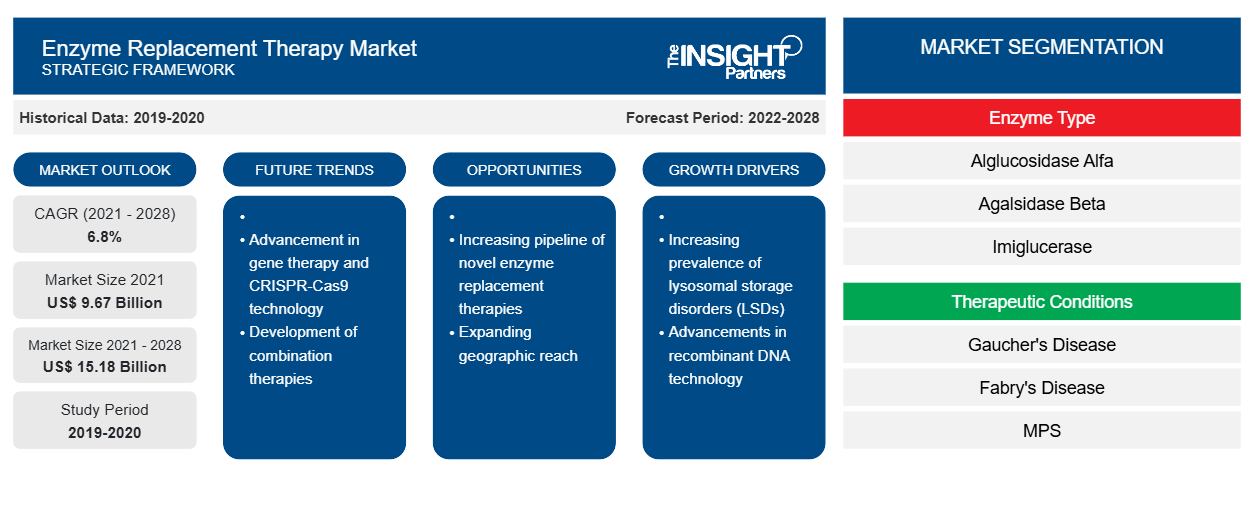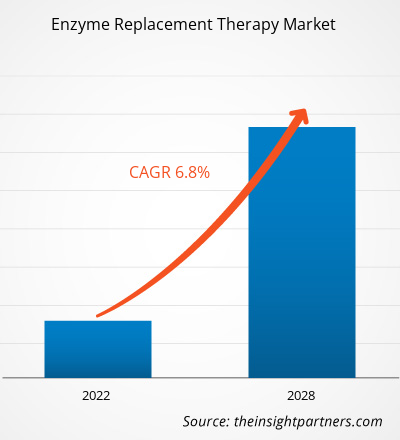酵素補充療法市場は、2021年の96億7,339万米ドルから2028年には151億8,470万米ドルに成長すると予想されており、 2022年から2028年にかけて6.8%のCAGRで成長すると予測されています。
酵素補充療法(ERT)は、酵素または酵素活性を持つタンパク質を使用して先天性酵素欠乏症を治療するために行われます。動物、ヒト、および組み換え工学酵素は、治療に必要な酵素のいくつかの供給源です。この療法は一般に、ポンペ病、ファブリー病、ゴーシェ病、テイ・サックス病、およびハーラー症候群を含む希少疾患およびリソソーム蓄積疾患に適用されます。最も一般的なERT法はIV注入であり、補充酵素は制御された点滴液を介して血流に直接投与されます。世界の酵素補充療法市場の成長は、リソソーム蓄積疾患( LSD ) の有病率の上昇と、希少疾病用医薬品指定を受けた医薬品に対する他のマーケティング上の利点を伴う迅速な規制承認に起因しています。ただし、市場プレーヤー間の熾烈な競争が市場の成長を妨げています。
このレポートは、世界の酵素補充療法市場に関する洞察と詳細な分析を提供し、市場動向、技術の進歩、市場のダイナミクス、世界の主要市場プレーヤーの競合状況分析など、さまざまなパラメータに重点を置いています。また、すべての地域の市場に対するCOVID-19パンデミックの影響も含まれています。COVID-19パンデミックにより、多くの保健当局はパンデミック関連のケアに焦点を当てました。さらに、2020年3月には、COVID-19患者の負担に対処する病院サービスの不十分さにより、酵素補充療法を必要とする多くの患者が点滴を受けられませんでした。ERTを必要とする患者は、入院中または薬の供給に関して不安を感じていると主張しました。また、研究により、一部の患者はうつ病と不安の増加を患っていることが明らかになりました。そのため、COVID-19パンデミック中に予定されていた酵素補充療法(ERT)セッションが中断され、市場に悪影響を及ぼしました。
要件に合わせてレポートをカスタマイズする
このレポートの一部、国レベルの分析、Excelデータパックなど、あらゆるレポートを無料でカスタマイズできます。また、スタートアップや大学向けのお得なオファーや割引もご利用いただけます。
- このレポートの主要な市場動向を入手してください。この無料サンプルには、市場動向から見積もりや予測に至るまでのデータ分析が含まれます。
地理に基づく洞察
地域別に見ると、世界の酵素補充療法市場は、北米(米国、カナダ、メキシコ)、欧州(フランス、ドイツ、英国、スペイン、イタリア、その他の欧州)、アジア太平洋(中国、インド、日本、オーストラリア、韓国、その他のアジア太平洋)、中東およびアフリカ(サウジアラビア、UAE、南アフリカ、その他の中東・アフリカ)、南米および中米(ブラジル、アルゼンチン、その他の南米および中米)に分類されます。
市場分析
リソソーム蓄積疾患(LSD)の罹患率の上昇
リソソームは、消化酵素を含む膜結合細胞小器官です。リソソームは、高分子の異化、リサイクル、およびシグナル伝達の重要な細胞ハブです。これらの機能に欠陥があると、リソソームに高分子が蓄積または貯蔵され、細胞が損傷します。リソソーム蓄積症 (LSD) の主な原因は、リソソーム酵素をコードする遺伝子の変異です。さらに、LSD は、酵素の欠如または欠乏をもたらす先天性代謝エラーとして特徴付けられます。子供は片親または両親から欠陥遺伝子を受け継ぐ可能性があるため、乳児や子供は成人に比べてより深刻な被害を受けます。しかし、過去 10 年間でパターンは変化しており、LSD は成人でより一般的です。
さらに、LSD にはゴーシェ病、ニーマン ピック病、ファブリー病、テイ サックス病、ムコ多糖症 (MPS)、ポンペ病など、約 70 の疾患が含まれます。これらの疾患は個別にはまれですが、全体としてはかなりの有病率で、出生児 5,000 人に 1 人が罹患しています。多くの国が有病率のパターンを把握するために調査を実施しましたが、全体的な有病率は上昇しています。たとえば、The Lancet Regional Health に掲載された「2009 年から 2020 年までのオーストラリアにおけるリソソーム蓄積疾患の有病率」という研究があります。この研究では、次の結果が明らかになりました。
- オーストラリアの人口における有病率は 1.6 倍 (出生 4,800 人中 1 人) であり、1996 年に報告された有病率 (出生 7,700 人中 1 人) よりも高くなっています。
- 最も多く見られたのはファブリー病で、全診断の 34% を占めています (2020 年まで)。
- LSDは子供時代よりも成人期に多くみられる
このように、LSDの蔓延と病気を治すための限られた治療法の増加は、世界の酵素補充療法市場の成長を牽引しています。
酵素の種類に基づく洞察
酵素の種類に基づいて、世界の酵素補充療法市場は、アルグルコシダーゼアルファ、アガルシダーゼベータ、イミグルセラーゼ、イデュルスルファーゼ、ガルスルファーゼ、ベラグルセラーゼアルファ、およびその他の酵素に分類されます。 2021年には、その他の酵素セグメントが最大の市場シェアを占めました。同じセグメントは、2022年から2028年にかけて市場で最高のCAGRを記録すると予想されています。
治療条件に基づく洞察
治療条件に基づいて、世界の酵素補充療法市場は、ゴーシェ病、ファブリー病、ポンペ病、SCID、MPS、およびその他の治療条件に分類されます。ゴーシェ病セグメントは2021年に最大の市場シェアを占め、予測期間中に最高のCAGRを記録すると予想されます。
投与経路に基づく洞察
投与経路に基づいて、世界の酵素補充療法市場は非経口と経口に分かれています。非経口セグメントは2021年に大きな市場シェアを占め、予測期間中に高いCAGRを記録すると予想されます。
酵素補充療法市場の地域別分析
予測期間を通じて酵素補充療法市場に影響を与える地域的な傾向と要因は、Insight Partners のアナリストによって徹底的に説明されています。このセクションでは、北米、ヨーロッパ、アジア太平洋、中東、アフリカ、南米、中米にわたる酵素補充療法市場のセグメントと地理についても説明します。

- 酵素補充療法市場の地域別データを入手
酵素補充療法市場レポートの範囲
| レポート属性 | 詳細 |
|---|---|
| 2021年の市場規模 | 96億7千万米ドル |
| 2028年までの市場規模 | 151億8千万米ドル |
| 世界のCAGR(2021年~2028年) | 6.8% |
| 履歴データ | 2019-2020 |
| 予測期間 | 2022-2028 |
| 対象セグメント | 酵素の種類別
|
| 対象地域と国 | 北米
|
| 市場リーダーと主要企業プロフィール |
|
酵素補充療法市場のプレーヤー密度:ビジネスダイナミクスへの影響を理解する
酵素補充療法市場は、消費者の嗜好の変化、技術の進歩、製品の利点に対する認識の高まりなどの要因により、エンドユーザーの需要が高まり、急速に成長しています。需要が高まるにつれて、企業は提供を拡大し、消費者のニーズを満たすために革新し、新たなトレンドを活用し、市場の成長をさらに促進しています。
市場プレーヤー密度とは、特定の市場または業界内で活動している企業または会社の分布を指します。これは、特定の市場スペースに、その市場規模または総市場価値に対してどれだけの競合相手 (市場プレーヤー) が存在するかを示します。
酵素補充療法市場で事業を展開している主要企業は次のとおりです。
- サノフィ
- バイオマリン製薬株式会社
- 武田薬品工業株式会社
- アッヴィ株式会社
- ヤンセンファーマシューティカルズ(ジョンソン・エンド・ジョンソン・サービス社)
免責事項:上記の企業は、特定の順序でランク付けされていません。

- 酵素補充療法市場のトップキープレーヤーの概要を入手
エンドユーザーベースの洞察
エンドユーザーに基づいて、世界の酵素補充療法市場は、病院、点滴センター、その他に分類されます。病院セグメントは2021年に最大の市場シェアを占めました。ただし、点滴センターセグメントは予測期間中に最高のCAGRを記録すると予想されます。
世界の酵素補充療法市場のプレーヤーは、製品の発売や拡大を含む有機的な戦略を採用して、世界中でその拠点と製品ポートフォリオを拡大し、高まる需要に対応しています。市場に貢献している主要なプレーヤーには、武田薬品工業株式会社、サノフィSA、アッヴィ株式会社、バイオマリン製薬株式会社、アミカスセラピューティクス、アレクシオンファーマシューティカルズ株式会社(アストラゼネカ)、ヤンセンファーマシューティカルズ株式会社(ジョンソン・エンド・ジョンソン・サービス株式会社)、レコルダティSpA、ファイザー株式会社、およびCHIESIファーマシューティチSpAがあります。
- 過去2年間の分析、基準年、CAGRによる予測(7年間)
- PEST分析とSWOT分析
- 市場規模価値/数量 - 世界、地域、国
- 業界と競争環境
- Excel データセット



Report Coverage
Revenue forecast, Company Analysis, Industry landscape, Growth factors, and Trends

Segment Covered
This text is related
to segments covered.

Regional Scope
North America, Europe, Asia Pacific, Middle East & Africa, South & Central America

Country Scope
This text is related
to country scope.
よくある質問
Global enzyme replacement therapy market is segmented by region into North America, Europe, Asia Pacific, Middle East & Africa, and South & Central America. In North America, the U.S. is the largest market for enzyme replacement therapy market. A rise in the prevalence of lysosomal storage diseases such as Gaucher’s, Pompe’s, and Fabry’s diseases, increasing regulatory approval, favorable regulatory support by the government, and the availability of various ERT products will drive enzyme replacement therapy market growth in North America. However, the growing government funding for rare disease treatment, increasing clinical trials, an increasing number of product approvals, and expanding partnerships among key players are the key factors responsible for the Asia-Pacific regional growth of the enzyme replacement therapy market accounting fastest growth in the region during the coming years.
The hospitals segment dominated the global enzyme replacement therapy market and accounted for the largest market share of 49.00% in 2021.
Takeda Pharmaceutical Company Limited, Sanofi, AbbVie Inc., BioMarin Pharmaceutical Inc., Amicus Therapeutics, Alexion Pharmaceuticals, Inc.(AstraZeneca), Janssen Pharmaceuticals (Johnson & Johnson Services, Inc.), Recordati S.p.A., Pfizer Inc., and CHIESI Farmaceutici S.p.A. are among the leading companies operating in the enzyme replacement therapy market
Based on route of administration, parenteral route of administration segment took the forefront lead in the worldwide market by accounting largest share in 2021 and is expected to continue to do so till the forecast period.
Based on therapeutic conditions, Gaucher's disease segment took the forefront lead in the worldwide market by accounting largest share in 2021 and is expected to continue to do so till the forecast period.
Based on enzyme type, other enzymes segment took the forefront lead in the worldwide market by accounting largest share in 2021 and is expected to continue to do so till the forecast period. Other enzymes include taliglucerase, laronidase, agalsidase alfa, eliglustat, cipaglucosidase alfa, miglustat, elosulfase alfa, elapegademase, velmanase alfa, pancreatic enzymes, pegademase, sebelipase alfa, cerliponase alfa, among others.
Enzyme replacement therapy (ERT) is a treatment that replaces enzymes that are not present or are deficient in the body. This is usually done by giving the patient an intravenous (IV) infusion or oral solution in which the enzyme is present. ERT is available for various lysosomal storage diseases which include Fabry’s disease, Gaucher’s disease, Pompe’s disease, MPS, and others. The ERT only increases the concentration of the enzymes which is lacking in the patient body and it does not correct any underlying genetic defect. ERT has also been used to treat patients with severe combined immunodeficiency (SCID) resulting from an adenosine deaminase deficiency (ADA-SCID).
Rising prevalence of lysosomal storage diseases (LSDS) and rapid regulatory approval with other benefits for drug with orphan drug designation are the most significant factors responsible for the overall market growth.
Trends and growth analysis reports related to Life Sciences : READ MORE..
The List of Companies - Enzyme Replacement Therapy Market
- Sanofi
- BioMarin Pharmaceutical Inc.
- Takeda Pharmaceutical Company Limited
- AbbVie Inc.
- Janssen Pharmaceuticals (Johnson & Johnson Services, Inc.)
- Alexion Pharmaceuticals, Inc (AstraZeneca)
- Amicus Therapeutics
- Recordati S.p.A.
- CHIESI Farmaceutici S.p.A.
- Pfizer Inc.
The Insight Partners performs research in 4 major stages: Data Collection & Secondary Research, Primary Research, Data Analysis and Data Triangulation & Final Review.
- Data Collection and Secondary Research:
As a market research and consulting firm operating from a decade, we have published and advised several client across the globe. First step for any study will start with an assessment of currently available data and insights from existing reports. Further, historical and current market information is collected from Investor Presentations, Annual Reports, SEC Filings, etc., and other information related to company’s performance and market positioning are gathered from Paid Databases (Factiva, Hoovers, and Reuters) and various other publications available in public domain.
Several associations trade associates, technical forums, institutes, societies and organization are accessed to gain technical as well as market related insights through their publications such as research papers, blogs and press releases related to the studies are referred to get cues about the market. Further, white papers, journals, magazines, and other news articles published in last 3 years are scrutinized and analyzed to understand the current market trends.
- Primary Research:
The primarily interview analysis comprise of data obtained from industry participants interview and answers to survey questions gathered by in-house primary team.
For primary research, interviews are conducted with industry experts/CEOs/Marketing Managers/VPs/Subject Matter Experts from both demand and supply side to get a 360-degree view of the market. The primary team conducts several interviews based on the complexity of the markets to understand the various market trends and dynamics which makes research more credible and precise.
A typical research interview fulfils the following functions:
- Provides first-hand information on the market size, market trends, growth trends, competitive landscape, and outlook
- Validates and strengthens in-house secondary research findings
- Develops the analysis team’s expertise and market understanding
Primary research involves email interactions and telephone interviews for each market, category, segment, and sub-segment across geographies. The participants who typically take part in such a process include, but are not limited to:
- Industry participants: VPs, business development managers, market intelligence managers and national sales managers
- Outside experts: Valuation experts, research analysts and key opinion leaders specializing in the electronics and semiconductor industry.
Below is the breakup of our primary respondents by company, designation, and region:

Once we receive the confirmation from primary research sources or primary respondents, we finalize the base year market estimation and forecast the data as per the macroeconomic and microeconomic factors assessed during data collection.
- Data Analysis:
Once data is validated through both secondary as well as primary respondents, we finalize the market estimations by hypothesis formulation and factor analysis at regional and country level.
- Macro-Economic Factor Analysis:
We analyse macroeconomic indicators such the gross domestic product (GDP), increase in the demand for goods and services across industries, technological advancement, regional economic growth, governmental policies, the influence of COVID-19, PEST analysis, and other aspects. This analysis aids in setting benchmarks for various nations/regions and approximating market splits. Additionally, the general trend of the aforementioned components aid in determining the market's development possibilities.
- Country Level Data:
Various factors that are especially aligned to the country are taken into account to determine the market size for a certain area and country, including the presence of vendors, such as headquarters and offices, the country's GDP, demand patterns, and industry growth. To comprehend the market dynamics for the nation, a number of growth variables, inhibitors, application areas, and current market trends are researched. The aforementioned elements aid in determining the country's overall market's growth potential.
- Company Profile:
The “Table of Contents” is formulated by listing and analyzing more than 25 - 30 companies operating in the market ecosystem across geographies. However, we profile only 10 companies as a standard practice in our syndicate reports. These 10 companies comprise leading, emerging, and regional players. Nonetheless, our analysis is not restricted to the 10 listed companies, we also analyze other companies present in the market to develop a holistic view and understand the prevailing trends. The “Company Profiles” section in the report covers key facts, business description, products & services, financial information, SWOT analysis, and key developments. The financial information presented is extracted from the annual reports and official documents of the publicly listed companies. Upon collecting the information for the sections of respective companies, we verify them via various primary sources and then compile the data in respective company profiles. The company level information helps us in deriving the base number as well as in forecasting the market size.
- Developing Base Number:
Aggregation of sales statistics (2020-2022) and macro-economic factor, and other secondary and primary research insights are utilized to arrive at base number and related market shares for 2022. The data gaps are identified in this step and relevant market data is analyzed, collected from paid primary interviews or databases. On finalizing the base year market size, forecasts are developed on the basis of macro-economic, industry and market growth factors and company level analysis.
- Data Triangulation and Final Review:
The market findings and base year market size calculations are validated from supply as well as demand side. Demand side validations are based on macro-economic factor analysis and benchmarks for respective regions and countries. In case of supply side validations, revenues of major companies are estimated (in case not available) based on industry benchmark, approximate number of employees, product portfolio, and primary interviews revenues are gathered. Further revenue from target product/service segment is assessed to avoid overshooting of market statistics. In case of heavy deviations between supply and demand side values, all thes steps are repeated to achieve synchronization.
We follow an iterative model, wherein we share our research findings with Subject Matter Experts (SME’s) and Key Opinion Leaders (KOLs) until consensus view of the market is not formulated – this model negates any drastic deviation in the opinions of experts. Only validated and universally acceptable research findings are quoted in our reports.
We have important check points that we use to validate our research findings – which we call – data triangulation, where we validate the information, we generate from secondary sources with primary interviews and then we re-validate with our internal data bases and Subject matter experts. This comprehensive model enables us to deliver high quality, reliable data in shortest possible time.


 このレポートの無料サンプルを入手する
このレポートの無料サンプルを入手する